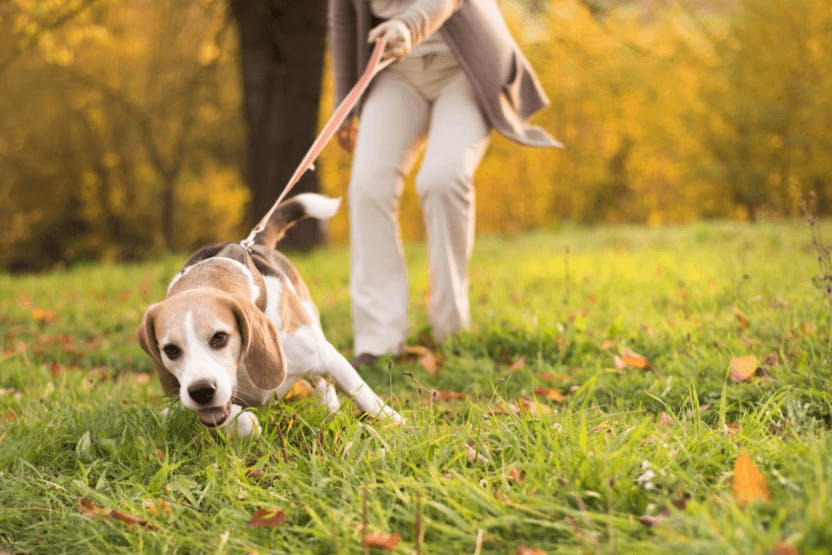Does your dog constantly pull on the leash during walks, turning what should be a relaxing activity into a tug-of-war? A dog that never stops pulling can make walking stressful and even lead to safety issues for both you and your pet. Fortunately, with the right techniques and patience, you can help your dog learn to walk calmly by your side. This guide offers practical tips on why dogs pull, how to train them to stop, and the best tools to make every walk more enjoyable.
Why Do Dogs Pull on the Leash?
Before we dive into training tips, it’s essential to understand why dogs pull in the first place. Pulling is often a natural response, as dogs are curious animals and want to explore their surroundings. Here are some of the main reasons dogs may pull on the leash:
1. Excitement: Dogs often pull because they’re excited to get to a specific destination or explore new smells and sights.
2. Lack of Training: If a dog hasn’t been trained to walk on a leash, it will likely pull as it has no sense of expected behavior.
3. Reinforcement of Pulling: Often, owners unintentionally reinforce pulling by allowing the dog to move forward when they pull, teaching the dog that pulling gets them what they want.
4. High Energy Levels: Energetic breeds, especially young dogs, may pull due to pent-up energy. Walking becomes an outlet for them to release that energy.
How to Train Your Dog to Stop Pulling on the Leash
While leash-pulling may be common, it’s an easy behavior to correct with consistency and the right methods. Here’s a step-by-step guide on how to teach your dog to walk calmly on a leash:
1. Use the Right Equipment
• No-Pull Harness: Unlike standard collars, no-pull harnesses are designed to discourage pulling and give you more control.
• Head Halter: This tool helps gently steer the dog’s head in the direction you want to go. Remember to introduce it gradually, as some dogs may need time to adjust.
2. Practice Loose-Leash Walking
• Start Training Indoors: Begin teaching your dog to walk on a loose leash in a quiet environment like your home or backyard to minimize distractions.
• Reward for Staying Close: Keep treats in hand and reward your dog whenever they walk calmly beside you. This positive reinforcement helps them associate calm walking with treats and praise.
3. The “Stop-and-Go” Technique
• Stop Moving When They Pull: Whenever your dog starts pulling, stop walking immediately. Wait until they return to you or loosen the leash, then start walking again.
• Be Consistent: This teaches your dog that pulling won’t get them where they want to go. Consistency is key; even one exception can reinforce pulling.
4. The “Turn Around” Method
• Redirect Their Attention: If your dog pulls, turn and walk in the opposite direction. This makes your dog pay more attention to your movements, helping them understand that following you is rewarding.
• Offer Treats When They Follow: Encourage your dog to follow you by using treats and praise. They’ll soon learn that sticking with you brings rewards.
5. Use Short Training Sessions
• Practice in Short Bursts: Instead of long walks, focus on short, 5-10 minute training sessions multiple times a day. This helps your dog learn the behavior without becoming overwhelmed.
• Increase Distractions Gradually: As your dog improves, gradually introduce distractions like new environments, other people, or dogs to reinforce their leash manners.
Best Tools to Stop Leash Pulling
The right tools can make a big difference in training your dog to walk calmly. Here are some popular options:
1. Front-Clip Harness: These harnesses have the leash attachment at the chest, which helps prevent pulling and gives you better control over your dog’s movement.
2. Gentle Leader Head Halter: Designed to gently guide your dog’s head, this tool is effective for larger or strong-willed dogs. Be sure to introduce it slowly to avoid discomfort.
3. Clicker for Training: A clicker can be used to mark good behavior. When your dog walks beside you without pulling, click and give a treat to reinforce this behavior.
Mistakes to Avoid When Training Your Dog Not to Pull
Correcting leash pulling requires patience, and it’s essential to avoid common mistakes that could undermine your training efforts:
1. Yanking or Jerking the Leash: Pulling back hard on the leash can be confusing and stressful for your dog, potentially worsening the behavior.
2. Inconsistent Training: Letting your dog pull occasionally, even if just to say hello to someone, can undo your progress. Consistency is crucial to successful training.
3. Skipping Exercise: Sometimes, dogs pull on the leash because they have too much energy. Giving your dog a chance to burn off energy before a walk, such as with playtime or a backyard run, can make leash training easier.
Final Tips for Success
Walking calmly on a leash won’t happen overnight, but with patience and consistency, your dog can learn to walk without pulling. Here are some final tips for success:
• Stay Calm and Patient: Dogs can sense frustration, so stay relaxed and keep a positive tone.
• Reward Progress: Celebrate small victories, like when your dog walks a few steps without pulling. Positive reinforcement builds confidence and reinforces good behavior.
• Practice Regularly: Daily practice, even for just a few minutes, will speed up the learning process.
Wrapping Up: Enjoying Walks with a Calm, Happy Dog
Training a dog to stop pulling on the leash can transform your daily walks, making them a time for bonding rather than a struggle. With the right approach and tools, you can teach your dog that walking by your side brings rewards and is far more enjoyable than pulling. Take it step-by-step, reward often, and enjoy the progress as you and your furry friend work together for peaceful, enjoyable walks.



Share:
Do Pet Reptiles Like Music? Exploring the World of Sound for Your Scaled Friends
Pet Sitter vs. Pet Hotel: Which is Best for Your Furry Friend?